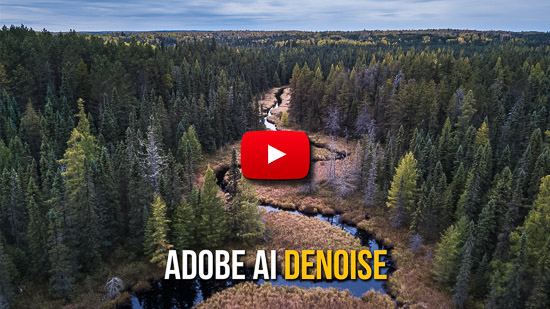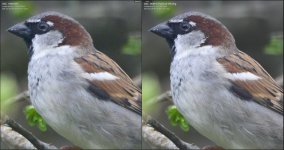- Messages
- 3,267
- Name
- Graham
- Edit My Images
- No
It's not showing up as update for me, but the just released version of lightroom classic has AI denoising that works with Bayer and xtrans
Did you get a notification of it being available?Trying it now. I'll let you know what it looks like in about an hour!
On my desktop (PC) I did. It wouldn't update straight away though.Did you get a notification of it being available?
I updated PS yesterday in response to a notification but nothing about Lightroom. I imagine they stagger notifications to avoid overloading the servers, and maybe, as I came across the Adobe page by accident, its only "just" been released.
Blooming typical that this arrives literally hours after I laid out some dosh for DxO PureRAW exactly for AI Denoising to DNG (although it is very good at the job and possibly better than Adobe’s effort)It's not showing up as update for me, but the just released version of lightroom classic has AI denoising that works with Bayer and xtrans
I suspect LR is going to only work on original raw files (I might be wrong) so it will probably be an either/or when it comes to using LR or DXO for noise reduction.Blooming typical that this arrives literally hours after I laid out some dosh for DxO PureRAW exactly for AI Denoising to DNG (although it is very good at the job and possibly better than Adobe’s effort)


Blooming typical that this arrives literally hours after I laid out some dosh for DxO PureRAW exactly for AI Denoising to DNG (although it is very good at the job and possibly better than Adobe’s effort)
I'm using a Macbook Pro with M1 chip, it's faster than Topaz with better results for sure and on par with DXO Pure Raw 3 in terms of speed and quality of final image in my opinion.As you may expect, loads of reviews on YouTube.
They all seem favourable and compare well with the other main products. How are you folks finding the speed? Particularly when compared to Topaz and the like.
I only have the Adobe products as supplied with Photography Plan.
S'ok now. I use the online chat to get someone at Adobe. I had to uninstall LRC, reboot then reinstall -- all functioning now. Thanks anyway.Is your operating system up to date?
I was thinking about getting DXO but now this has come out I can save myself £115, so that's next years LR subscription taken care of, result!
That's reassuring, thanks.I'm using a Macbook Pro with M1 chip, it's faster than Topaz with better results for sure and on par with DXO Pure Raw 3 in terms of speed and quality of final image in my opinion.
DXO Pure raw is much better.Blooming typical that this arrives literally hours after I laid out some dosh for DxO PureRAW exactly for AI Denoising to DNG (although it is very good at the job and possibly better than Adobe’s effort)
DXO Pure raw is much better.
Not only do you get the lens corrections but DXO produces a sharper image with more refined detail. LR gets a bit mushy.
You get lens corrections in LR and imo they are better. Something that made me hesitate about DXO was although the lens corrections were apparently applied, when the processed file was imported back into LR the lens correction had to be applied again as it seemed to lose it when exporting from DXO.DXO Pure raw is much better.
Not only do you get the lens corrections but DXO produces a sharper image with more refined detail. LR gets a bit mushy.
Never had that problem myself.You get lens corrections in LR and imo they are better. Something that made me hesitate about DXO was although the lens corrections were apparently applied, when the processed file was imported back into LR the lens correction had to be applied again as it seemed to lose it when exporting from DXO.
Yeah it's a weird one, says all lens profiles downloaded and after DXO has finished you can see it's been applied but reverts back after importing to LR, needs further investigation.Never had that problem myself.
 No Noise reduction by FusionX Photo, on Flickr
No Noise reduction by FusionX Photo, on Flickr New Adobe Denoise Applied by FusionX Photo, on Flickr
New Adobe Denoise Applied by FusionX Photo, on Flickr DXO Pure Raw 3 Deep Prime Applied by FusionX Photo, on Flickr
DXO Pure Raw 3 Deep Prime Applied by FusionX Photo, on Flickr
I've learnt not to see noise as the enemy, having said that there's a big difference between how it appears depending on the image. An under exposed high iso image will look awful when raising the shadows so I take more care these days to try and get the exposure right. Personally, I find blown highlights offend my eyes far more than a bit of grain.I'm pleased that I now have denoising software as part of my LR subscription but I had pretty much decided (before it was announced) that the number of times I would want it at all did not merit the -- for DXO -- £115 cost. Looking at the pictures above, by Pete, shows that unless one is pixel-peeping, there is absolutely no discernible difference between the images as displayed. Now whether or not differences would show up in printing rather than on a screen, I have yet to determine, but de-noising software, to my old and jaundiced eye, seems to be a solution looking for a problem that doesn't really exist.
I'll get my coat
I'm pleased that I now have denoising software as part of my LR subscription but I had pretty much decided (before it was announced) that the number of times I would want it at all did not merit the -- for DXO -- £115 cost. Looking at the pictures above, by Pete, shows that unless one is pixel-peeping, there is absolutely no discernible difference between the images as displayed. Now whether or not differences would show up in printing rather than on a screen, I have yet to determine, but de-noising software, to my old and jaundiced eye, seems to be a solution looking for a problem that doesn't really exist.
I'll get my coat
